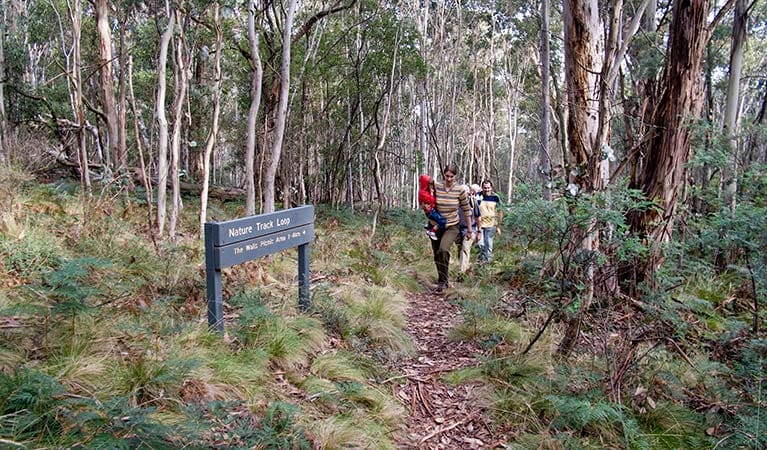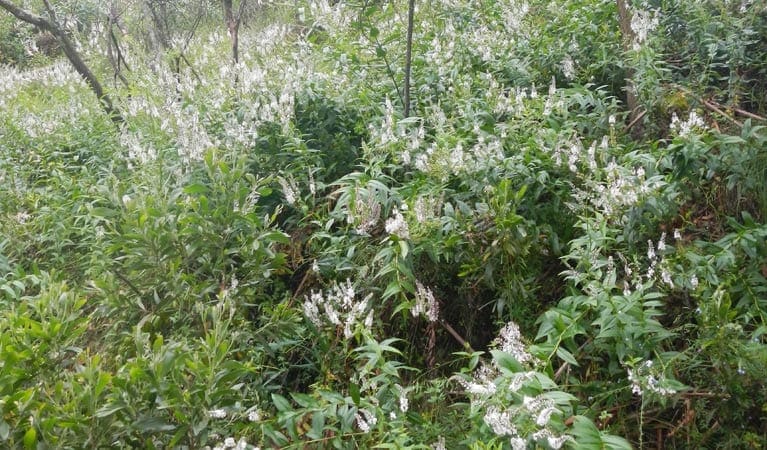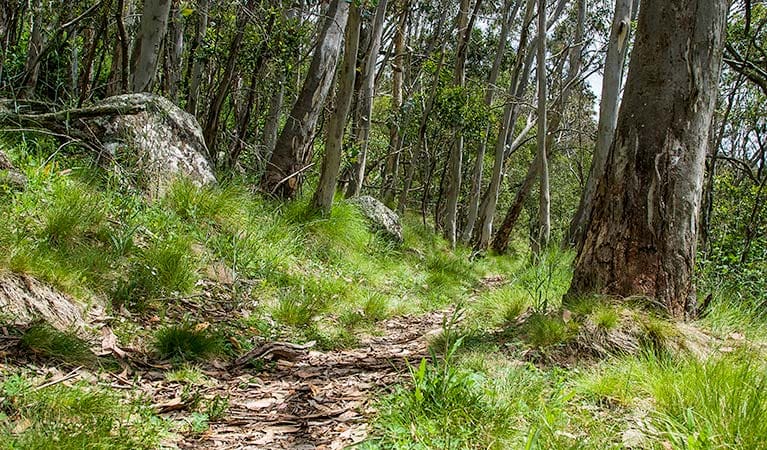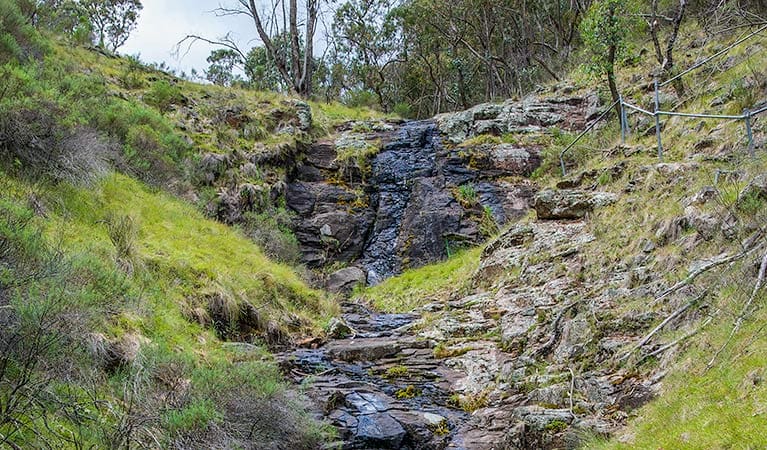Trail Fast Facts
Summits walking track is a 2.1km, grade 3 hike in Mount Canobolas State Conservation Area, New South Wales. This hike typically takes 1 hour to complete.
Hike Overview
Summits walking track connects two of the park's summits, Mount Canobolas (also known as Old Man Canobolas) and Young Man Canobolas, traversing a saddle between to two mountains and joining up with some of the other walking tracks along the way.
Before you head off on the walk, take some time to admire the scenic view from the summit of Old Man Canobolas; you'll be able to see the town of Orange and surrounding countryside.
When you're on your way, you'll first hike along a downhill track that passes through snowgum grassy woodland. Keep an eye out for grey currawongs during summer and look for white throated tree creepers. From there, you'll wind uphill to the summit of Young Man Canobolas.
If you'd like to turn this short walk into a longer day walk, you can join up with the Spring Glade, Snowgum or Nature tracks; look out for signage along the way.
Track Grade
Grade 3 (Moderate) - Walks for Most Fitness Levels: Grade 3 on the AWTGS represents moderate walking tracks. These are ideal for walkers with some fitness who are comfortable with some hills and uneven terrain. While suitable for most ages, some bushwalking experience is recommended to ensure a safe and enjoyable experience. Tracks may have short, steep hill sections, a rough surface, and many steps. The total distance of a Grade 3 walk can be up to 20 kilometers.
Tips
Because of the altitude, the weather can change quite quickly. You should always check the weather forecast before setting out for a walk. It's advisable to bring a jumper with you, and in winter always bring a raincoat and warm clothing.
Spring Glade, Snowgum and Nature walking tracks connect with Summits walking track - look for signage along the way
Remember to take your binoculars if you want to bird watch
Visit NSW National Parks and Wildlife Service for more information on this trail.
The longitude and latitude of the start and end points are approximately only and should not be used for navigation purposes. Please contact me if you know the correct coordinates.
Map and GPX file
Looks like I don’t have a GPX file for this trail yet. If you have one you’d be willing to share, please email it to me so we can help other hikers have a safer, easier time out there. I’ll double-check each file to make sure it aligns with official tracks and topo maps before adding it to this hike. Thanks so much for helping build an even better hiking resource.
Trailhead
Sorry, no records were found. Please adjust your search criteria and try again.
Sorry, unable to load the Maps API.
Getting there
On entering Mount Canobolas State Conservation Area, follow Mount Canobolas Road all the way to the summit of Mount Canobolas. Road quality Roads may close when it snows (generally once or twice each winter).
Photo gallery
If you’ve got some great shots from this hike, I’d love to see them! Please upload your .jpg files here to help inspire other hikers and show off the beauty of the trail.
A quick note: Uploading your photos doesn’t mean you lose ownership. You’ll be credited for any photos you share, and you can request to have them removed at any time.
About the region
Mount Canobolas State Conservation Area offers birdwatching, walking, scenic views, pretty picnic areas and a great campground; a top choice for a weekend getaway. The majestic Mount Canobolas is a dormant volcano that formed millions of years ago when Australia was sitting over a hotspot in the earth's crust. It is part of the Brigooda-Oberon chain that stretches 800km from southeast Queensland to near Oberon in NSW and last erupted eleven million years ago, spewing lava from the main vent and up to 30 vents in the surrounding area. With its rich soil, high altitude and cool climate, it's the perfect environment for a range of plants and animals. There are great places to picnic and a number of walking tracks, plus the park is only a short drive from Orange so it makes for a great daytrip. If you feel like a weekend getaway, there's also a campground that offers basic facilities in a pretty setting, right near the start of the Federal Falls walking track.
Suggest an edit
Spotted a change on this trail? Maybe there are new features, the route has shifted, or the trail is permanently closed. Whatever the update, I’d love your input. Your feedback helps fellow hikers stay informed and ensures that our trail info stays fresh and reliable.
Similar trails nearby
Looking for things to do in Mount Canobolas State Conservation Area or nearby? Try these similar hikes or bushwalks.
Let someone know
Adventure with Confidence: Register Your Trip Plans
Before you hit the trail, take a moment to fill out our trip intentions form. It’s a simple way to share important details about your hike with family or friends. If things don’t go as planned and you’re not back on time, they can easily notify emergency services, helping to ensure a quick response and reducing worry. Enjoy your outdoor adventure knowing that you’ve taken a smart step for your safety.
Gear to consider
What you carry in your pack will depend on the weather, terrain, time of year, type of adventure, and personal preferences. Having trouble deciding what gear’s right for you? My free planning, food and packing checklists provide an introduction to things your could consider (as well as the Ten Essentials) on your day, overnight and multi-day adventures. Customise your kit according to your personal needs, always considering safety first.
Explore Safe
While planning your hike, it’s important to check official government sources for updated information, temporary closures and trail access requirements. Before hitting the trail, check local weather and bushfire advice for planned burns and bushfire warnings and let someone know before you go. Plan ahead and hike safely.
Weather
Acknowledgement of Country
Trail Hiking Australia acknowledges the Traditional Owners of the lands on which we hike and pay respects to their Elders, past and present, and we acknowledge the First Nations people of other communities who may be here today.






